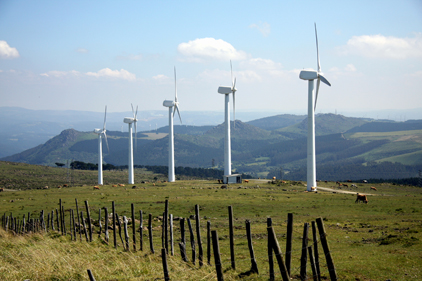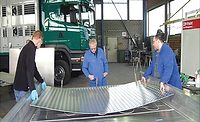
Epoxy adhesives play an important role in the fabrication, performance and durability of wind turbine blades.
Many industries are experiencing regulatory and pricing pressures that have resulted in changes to their traditional materials and processes. As this happens, adhesive technologies are quickly advancing to accommodate customer needs by enabling the use of a wider variety of materials and new manufacturing and product assembly processes. In some cases, adhesive technologies are even ahead of the game.
In the transportation industry, for example, market shifts are being driven by manufacturers’ need for increased weight savings to achieve better fuel efficiency and reduced carbon dioxide emissions. Manufacturers are moving away from all-steel vehicles and using reliable lighter weight materials like aluminum, magnesium, and sheet molding compound (SMC). Advanced lightweight materials like carbon fiber composites, glass fiber-reinforced polyamide (GFPA), glass fiber-reinforced polypropylene (GFPP), polycarbonate acrylonitrile butadiene styrene (PC-ABS) and polyurethane reaction injection molding (PUR-RIM) are also being used more often to accommodate evolving vehicle designs.
Design changes have also been significant, especially in commercial transportation markets as those manufacturers strive to develop and produce vehicles that are lighter weight and more fuel efficient. Longer adhesive open times are also an important consideration in this market, since large modules or multi-piece assemblies may have to be joined before the adhesive starts to cure.
As various materials interface, traditional joining technologies aren’t always sufficient under the required performance extremes. Adhesives, however, are being formulated to accommodate the bonding of these diverse, dissimilar substrates and manage differences in thermal expansion properties. The new adhesives offer high modulus, optimized elongation and broad service life temperature properties.
Manufacturing processes can also benefit from a greater use of adhesives in terms of joining costs and cycle times. Adhesives also can help reduce the risk of repetitive task injury to the workforce, especially where mechanical fastening methods are commonly used. A range of solutions are coming to market as next-generation adhesives, all with some degree of customization options to better meet customer and market needs.
Two-Part Polyurethane Adhesives
A new two-part polyurethane (PU) adhesive is now being applied in full structural bonding applications for automotive and commercial vehicle manufacturing. It provides ultra-fast curing, excellent temperature stability behavior, a broad range of mechanical properties, high modulus and elongation, a 1:1 (by volume) mixing ratio, and very good bead stability during applications.Typical bonded applications include automotive roof and hatchback bonding, as well as commercial transportation driver cabins. As material choices continue to diversify, this adhesive solution is addressing market concerns that focus on cost efficiencies, weight reduction, styling and design options, and environmental issues centered around fuel efficiency.

The continual bondline of the adhesive provides additional benefits, including improved durability, corrosion resistance, acoustical improvements and better crash performance.
MMA and MMA/Epoxy Hybrid Structural Adhesives
Methyl methacrylate (MMA) and MMA/epoxy hybrid structural adhesives provide fast, simplified joining operations with minimal surface preparation. They can be used to bond composite body panels, bumpers and exterior trim, cockpit structures, door extensions, and tail and lift gates.Greater design flexibility is enabled by primerless adhesion to a variety of substrates, including lightweight composites that also help manufacturers develop more fuel-efficient vehicles. These next-generation adhesives also provide fast room-temperature cure with lower fixture time-to-open time ratios. In addition, they exhibit high tensile modulus, stiffness and impact strength, and are e-coat compatible to accommodate systems requiring that treatment.
Additional Adhesive Solutions
Composite adhesives are being used for a growing number of applications outside the automotive industry as well. For example, Dow Formulated Systems recently developed a foam core system for wind blades that is bonded by epoxy adhesives. The new system offers long-term dynamic behavior and shear strength properties that deliver the excellent mechanical strength and fatigue resistance necessary to achieve blade durability.Epoxy adhesives play an important role in the fabrication, performance and durability of wind turbine blades, where large substructures are bonded together to create the finished blades. Specialized properties are needed for adhesive mixing and application during the fabrication process, and cured adhesives must exhibit high levels of toughness and durability to withstand the extreme loads a wind turbine will face throughout its service life.
In addition to wind energy solutions, adhesive formulation and application expertise is being leveraged into industries such as residential and commercial construction, infrastructure repair, oil and gas, appliance, furniture, shoe soles, decorative molding, and athletic equipment.
Looking Ahead
Industrial applications for adhesive technology are certain to grow as the need for innovative manufacturing and assembly practices evolves. Adhesives suppliers can be on the leading edge of this evolution by creating adhesive solutions that will enable these new practices. Dow Automotive Systems is off to a good start by combining several technologies for adhesively bonded composite structures, thereby laying the foundation to address long-lasting improvements in energy efficiency by mastering lightweight solutions with next-generation composites. This experience can then be shared across multiple industries to benefit customers and end users around the world.For more information, contact the author at Dow Automotive Systems, 1250 Harmon Rd., Auburn Hills, MI 48326; call (248) 391-6300; email fbillotto@dow.com; or visit www.dowautomotive.com.



